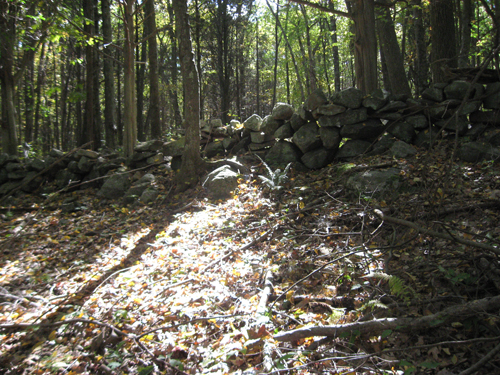Winter is well over the half-way point and we’ve had no snow to show for it. After last winter’s record-breaking snowfall amounts this is a bit unsettling. We did have a lot of snow and power outages for that freak Halloween Nor’easter in October, but that was an autumn storm, not truly a winter storm… What strange weather.
Bulbs are coming up months too early. Witch hazel is blooming at Mystic Seaport. Tim & I went for a walk on Saturday at Haley Farm State Park, looking for photo opportunities. The birds were chirping away as if it was a sunny spring day! This time it was warm enough for my fingers to hold the camera and take 86 pictures. Perhaps I should have tried a landscape setting for a few of them. But I’m still getting used to holding it properly and finding the shutter button at the same time…
Caleb Haley owned and farmed this land in Noank, Connecticut, and took on the daunting task of building stone walls between the pastures all over the property. The crumbling foundations of his house, stables and barns remain. In October of 1898, Walter Hill came from New York to visit his friend here and wrote an account of their time together. Excerpts following are from the Haley Farm Souvenir Book, found transcribed at the Groton History Online website.
If there is any one thing in which my friend delights more than another, it is the works of improvement which he is carrying forward at Haley Farm, Long Point; so breakfast dispatched we, of course, drove at once to the locality of the improvement now going forward.
~ Walter Hill
It may be mentioned here, that the land in this vicinity and for miles in all directions is covered with boulders, boulders large and boulders small, sometimes ledges, but boulders in all shapes, boulders in all positions, boulders on boulders—everywhere. The first settlers simply removed or cleared the smaller rocks, such as a horse could easily drag out of the way, leaving hundreds of heavier ones half embedded in the soil in all directions.
~ Walter Hill
Thus thousands upon thousands of acres of splendid soil have been fit for naught but cattle runs of natural pasturage. To clear such land of everything to obstruct the free running of a plow, is a herculean task and it is this wrestling with the stern face of nature, that I found to be the delight of my host. A forenoon spent in watching and assisting in the operations, found me deeply interested. A device called a “Stone-puller” was quite fetching, and was the invention of a near-by resident whom I was disappointed to learn had never realized much out of it, for without it, such operations as are here going forward, would be prohibited by the question of cost. Mr. H— has 428 acres of just such land as described; skirting the shores of L. I. Sound with deep coves running up on either side of his property; forming between them, Long Point, which is all included in the Haley Farm, with the exception of a tract on the extreme point, which is owned by parties who started to boom it for Summer cottage purposes, but came to a dead-lock with the town authorities regarding approaches, and who should bear their cost.
~ Walter Hill
According to the the Connecticut Department of Energy & Environmental Protection website:
In 1963 efforts to protect the farm from being sold to developers began. The State of Connecticut agreed to match funds raised for the purchase of the farm. The Groton Open Space Commission led a successful fund raising effort that led to the purchase of the property. Haley Farm became an official Connecticut State Park in July of 1970.
We found several burls on the outstretched branches of this tree:
I think this is a private boathouse across the water. I thought it looked especially cheerful and welcoming!
So we had a good time poking around our local historic “ruins” and enjoying the scenic views of Palmer Cove. It was nice enjoying a spring day in February, but I’m starting to get a little nervous about what weather we have in store for us this summer. For now, though, perhaps I can manage to stay in the present… It is what it is and what will be will be!































